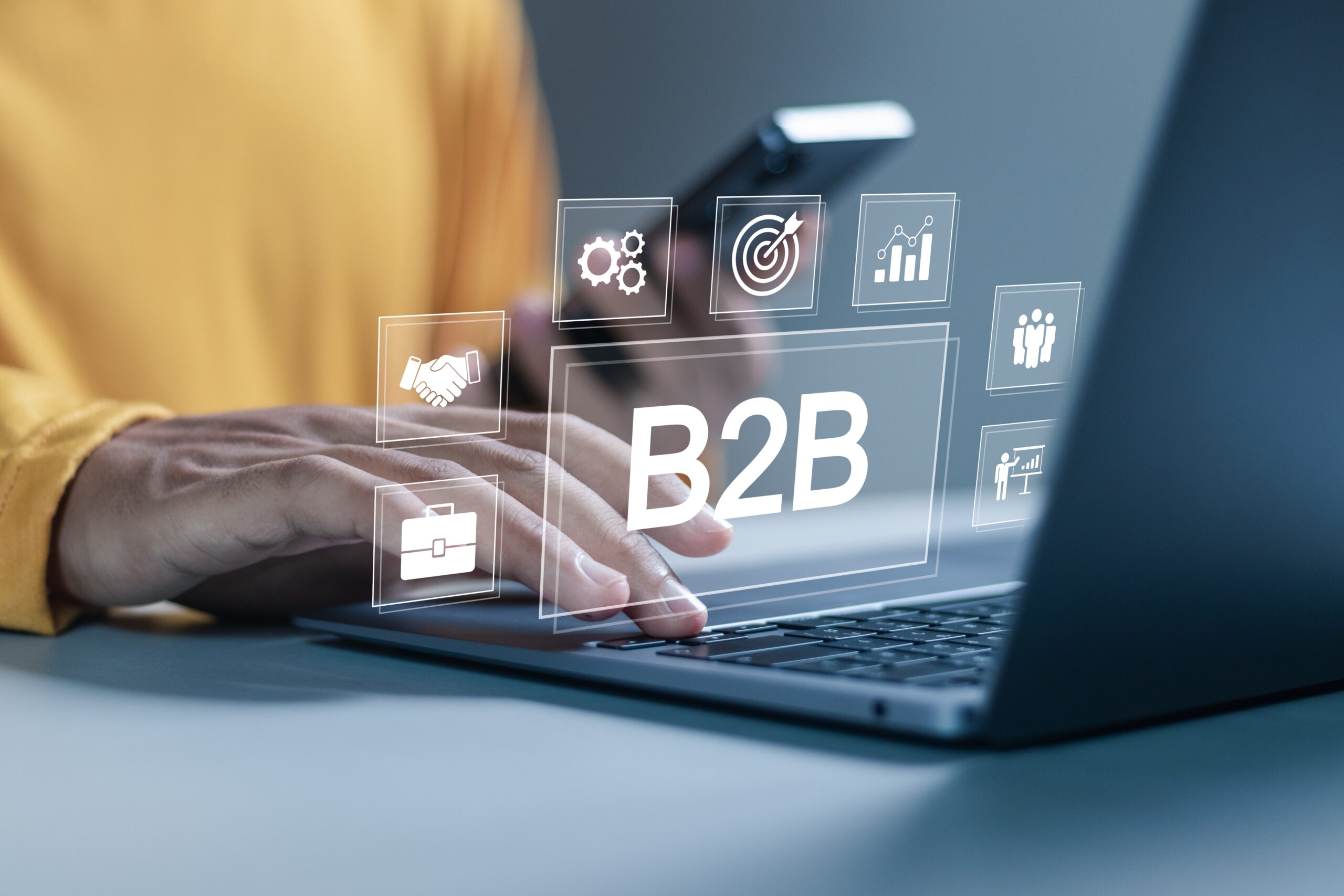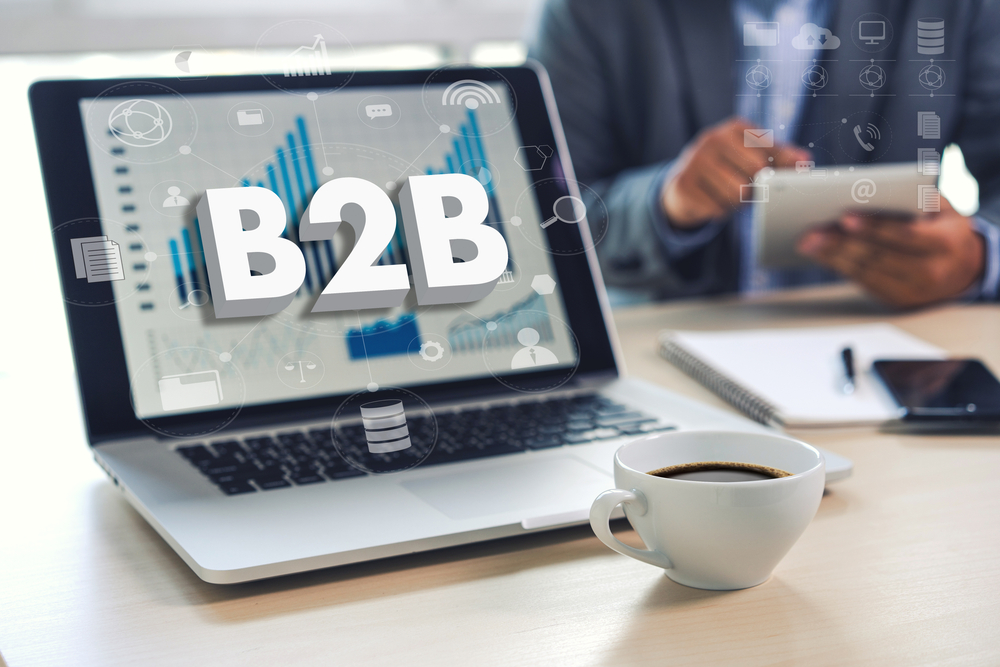Whether you’re a DTC brand venturing into B2B or a traditional retailer transitioning from in-person to online sales, here are the top 11 advantages of B2B ecommerce.
B2B ecommerce is projected to reach $7.7 trillion, more than doubling the $3.8 trillion in direct-to-consumer (DTC) sales. By 2025, 80% of all B2B sales are expected to take place online, with millennials—who prefer digital purchasing experiences—making up 70% of buyers.
As one of the fastest-growing sales models, nearly half of all B2B transactions are already happening online. In fact, a 2022 survey conducted with Shopify businesses found that 85% of B2B companies view centralized commerce as critical to success.
The important question is: Why are DTC brands increasing their focus on building B2B online experiences?

1. Boost brand recognition
For DTC-only brands, building brand recognition can be a challenge. Success in this area often depends on your customers’ willingness to spread the word about your products or on spending substantial sums on marketing.
However, selling through B2B channels like wholesale can significantly amplify brand recognition. When resellers purchase your products at wholesale prices, they take on the responsibility of promotion for you.
Whether it’s an online store or a physical retail location, your product packaging—complete with your logo, brand name, and any trademarked slogans—gains exposure through your retail partners’ platforms.
This advantage extends even to legacy B2B retailers who have traditionally relied on in-person sales. By shifting to B2B ecommerce, you can scale brand visibility by reaching a broader market. Instead of managing wholesale transactions manually, an online storefront empowers B2B buyers to self-serve, increasing both efficiency and reach.
The more B2B customers you serve, the greater the visibility of your products across various channels, helping you capture the attention of the general public.
2. Reduced B2B Marketing Expenses
In the DTC space, gaining visibility for products often requires a significant investment in marketing or advertising, which can be both costly and risky.
Recent updates, like Apple’s iOS 17, have made it harder for brands to track customer activity and assess the performance of marketing efforts. Additionally, Google’s phase-out of third-party cookies has caused a rise in the cost-per-click for search ads, with notable increases between the second and third quarters of 2021.
B2B ecommerce, however, offers a more economical solution. Resellers manage the promotion for you, placing your products in storefront displays, on department store shelves, and incorporating them into their digital campaigns. This means your B2B customers handle the marketing, saving your brand from spending heavily on promotional activities.
Marketing to B2B buyers also differs significantly from DTC. Business buyers prefer personalized, account-based marketing approaches, which are more cost-effective. Selling directly to other businesses is less expensive than broad, mass-market campaigns on social media platforms.

3. Lower Customer Acquisition Costs
With no marketing spend required, acquiring B2B customers becomes more cost-effective and profitable.
A real-world example is a bathworks business using Shopify, where the owner approached a retail store in person to pitch carrying the brand’s products. The only investment was time, which led to securing large orders. This straightforward approach to cold-pitching is a highly effective B2B sales strategy that isn’t easily scalable for DTC-only brands.
4. Higher Order Value and Volume
One of the key differences between B2B and DTC customers is the quantity and frequency of purchases. B2B buyers tend to place larger, more frequent orders—especially when the ordering process is simplified through a B2B ecommerce platform that allows for easy self-service. It’s common for B2B buyers to reorder significant quantities on a regular basis, whether that’s daily, weekly, or monthly.
Shopify enables businesses to offer top-tier wholesale experiences, featuring bulk ordering, personalized pricing, and a self-serve portal designed to meet the expectations of modern B2B buyers. As a result, B2B customers not only place larger orders, but they do so more often, increasing both order value and volume.
5. Built-In Loyalty for Predictable Revenue
In B2B commerce, customers often establish long-term relationships, meaning repeat purchases are more of a given. As long as the product meets expectations, there’s a mutual understanding that the partnership can last for years.
This built-in loyalty generates predictable revenue for your business. Unlike DTC companies, which are vulnerable to external factors like economic downturns or seasonal fluctuations, B2B customers tend to place regular orders to meet their own demand. This consistency provides greater cash flow certainty and allows for more accurate planning and scaling efforts.
6. Automated Sales and Business Processes
Managing B2B sales through traditional offline methods is often labor-intensive. Many B2B companies rely on manual processes, such as sales reps nurturing relationships, entering orders, and handling invoices or payment reminders. By moving B2B operations online, businesses can automate these tasks, speeding up sales cycles and reducing human error.
With Shopify, businesses can tap into a robust app ecosystem that enhances automation and customization. Shopify’s ecosystem, which includes over 10,000 apps, offers a wide range of tools to streamline workflows, personalize buyer experiences, and manage complex sales processes without needing extensive developer resources.
For example, Shopify’s integration with enterprise resource planning (ERP) systems allows B2B businesses to sync data across sales, inventory, and logistics, eliminating the manual effort of tracking these processes separately. Whether it’s automating order fulfillment or integrating shipping workflows, Shopify’s app ecosystem helps reduce manual tasks and simplify back-end operations. Tools like Shopify Flow automate routine tasks, such as notifying customers about low stock or processing reorders, saving valuable time and minimizing errors in B2B transactions.
In addition to automation, Shopify’s app ecosystem supports extensive customization, enabling businesses to offer bulk ordering, custom pricing, and personalized customer portals. These features create a seamless self-serve experience, which is essential for modern B2B buyers who expect the ease of online shopping alongside the flexibility of custom pricing and payment terms.

7. Simplify International Distribution
An online presence makes it easier for businesses to go global, allowing you to launch in new markets through a single DTC storefront. However, the logistical challenges of international expansion can be costly and time-consuming.
By expanding into B2B, you can offload distribution to your new customers. For instance, if you’re a US-based CPG brand, you can enter European markets by selling wholesale to B2B customers. Rather than managing international logistics yourself, you simply ship inventory to one location, and your resellers take on the role of distributing your products across the region.
8. Reduced Operational Costs
B2B orders naturally lead to lower operational costs. A single bulk order of over 100 units requires fewer shipping labels, boxes, and logistics than selling each item individually to end customers.
B2B buyers also prefer self-service options, which is another cost-saving benefit. Selling at scale through a customer-focused ecommerce platform reduces the need for expensive trade shows, manually processing orders, or sending invoice reminders.
A self-serve B2B ecommerce platform allows buyers to make purchases without consuming your valuable resources, freeing up your sales team to focus on building relationships, discussing new products, providing marketing support, and sharing insights on upcoming trends that help move your products.
Legacy systems often create operational bottlenecks due to manual processes for order management and invoicing, increasing errors and limiting scalability. Shopify, however, automates these tasks with features like bulk ordering tools, personalized storefronts, and flexible payment terms, significantly reducing manual work and cutting operational costs.
With Shopify, you can manage both B2B and DTC storefronts from a single backend, eliminating the need for two separate platforms. This unified system helps businesses:
The best part? You don’t need third-party apps to manage wholesale and DTC channels separately. Shopify provides B2B buyers with a personalized, seamless buying experience without the complexity or costs of maintaining two separate systems.

9. Enhanced Personalization and Customer Experience
Personalization has long been a priority in DTC, but it’s gaining even more attention in B2B. According to Gartner, while 71% of B2C customers expect personalization, 86% of B2B customers expect it during their interactions with companies.
However, DTC personalization often has its limits. It typically revolves around offering discounts and generalized customer journeys. In contrast, B2B ecommerce enables more advanced personalization, providing unique prices, contract agreements, and tailored experiences that cater to the specific needs of each business customer.
This higher level of customization is essential in B2B, where sales cycles are longer and more complex, often involving bulk orders or intricate needs like enterprise-level service plans. B2B companies must leverage data-driven insights that go beyond basic customer behaviors and purchase history. They need to understand individual decision-makers within a company, their roles, and the specific requirements of their business or industry.
Leading B2B ecommerce brands personalize every interaction across various channels—email, search ads, social media, AI chat, and website landing pages—tailored to each buyer persona. This approach works well in B2B, where sales cycles can stretch for months, and buyers engage with the brand multiple times before making a purchase decision.
DTC, on the other hand, typically relies on broader data such as browsing history, demographics, and past purchases to deliver personalized ads and emails. DTC also faces challenges that hinder deeper personalization, such as:
Ultimately, the richer the data, the easier it becomes to deliver personalized experiences and retain customers long-term. In this regard, B2B is currently leading the way.
10. Higher Customer Retention Through Ongoing Support
When a customer buys from a DTC company, they usually don’t receive much direct follow-up engagement. While support options like phone, email, or forums exist, post-purchase interactions are typically limited to a few product tips via email.
In contrast, B2B businesses offer more comprehensive support. Customers often receive a dedicated account manager who follows up through calls or emails, ensuring proper onboarding and providing ongoing assistance. This personalized support enhances the customer experience, as the account manager understands the client’s business needs and can offer more tailored advice.
Some B2B companies also provide self-serve resources, such as industry-specific knowledge bases with tutorials, videos, blog posts, and forums, all customized to the customer’s use case. This blend of dedicated account management and tailored self-serve options boosts customer satisfaction, driving higher retention rates. B2B companies that regularly survey their customers see an impressive 82% retention rate, compared to just 28% for DTC businesses.
If you offer dedicated account management, promote this feature to alleviate customer concerns and improve sales engagement.
11. Easier to Scale Business Operations
The B2B ecommerce model, with long-term relationships, bulk orders, lower marketing costs, and simplified international distribution, provides an ideal strategy for scaling operations. What truly sets scalable businesses apart is their ability to manage both B2B and DTC channels from a single platform, without building separate systems for each.
Shopify allows businesses to run both B2B and DTC operations from a single admin interface and store. This simplifies operations without sacrificing either sales model, enabling businesses to manage inventory, pricing, and customer relationships for both B2B buyers and DTC consumers through a unified backend.
For instance, Shopify enables businesses to display contextual pricing based on whether a customer is a B2B buyer or an end consumer. It also allows setting minimum and maximum order quantities for wholesale buyers, while offering discounts and personalized experiences for DTC shoppers—all from the same store. Whether selling in bulk to retailers or directly to consumers, Shopify’s unified system supports both models, providing the flexibility to scale across multiple sales channels without the complexity of managing separate ecommerce setups.
This seamless integration is particularly beneficial for hybrid businesses operating both B2B and DTC models. Shopify streamlines operations by merging workflows while offering customized storefronts, flexible payment terms, and a self-serve portal, allowing businesses to manage both B2B and DTC orders simultaneously and scale effectively.
References
¹Elise Dopson, “The 11 Top B2B Ecommerce Benefits (2025),” Shopify Enterprise Blog, September 10, 2024, https://www.shopify.com/enterprise/blog/b2b-ecommerce-benefits-advantages.
If you have questions or need assistance executing these strategies, our team is available at hello@tidalcommerce.ca.
Get monthly insights, case studies, and bold ideas from the front line of digital commerce & CX.